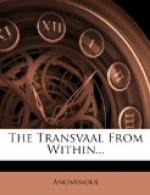59, HOLBORN VIADUCT, LONDON, E.C.
6th May,
1897.
REPORT ON THE LETTER WRITTEN ON A TORN TELEGRAM FORM SIGNED “F.R.”, BY MR. T.H. GURRIN, EXPERT IN HANDWRITING.
Mr. THOMAS HENRY GURRIN, of 59, Holborn Viaduct, London, E.C., is a professional expert in handwriting, recognized and employed by the Director of Public Prosecutions, the Home Office, and the authorities at Scotland Yard, and is constantly engaged by them in that capacity. He is also frequently engaged in the same capacity by the Bank of England and other public bodies.
He has acted as handwriting expert in a very large number of civil and criminal cases at sessions, assizes, and before the High Courts, for over twelve years past, and can conscientiously say that his experience in the identification of genuine handwriting and the detection of forged and altered documents is very extensive.
Mr. Gurrin begs respectfully to submit the following report:—
’Having been instructed by Mr. Braunstein, solicitor, of 27, Great George Street, Westminster, I have examined a photograph of torn portions of a letter written on a telegram form of the South African Republic.
’My attention has been directed to the evidence of Major Sir J.C. Willoughby, appearing at page 302 of the Minutes, in which he has given his version of the missing portions of this document.
’I have compared this version of the missing words with the vacant spaces, and I find that the words supplied in question 5,571 would occupy, as near as can be estimated, the missing spaces, judging from the other writing in the document.
’I read the first portion of the document as follows:—
’"Dear Dr.,
“The
rumour of massacre in”
“Johannesburg that started
you to our”
“relief was not true.
We are all right;”
“feeling intense; we have
armed”
“a lot of men. Shall
(not ‘I shall’) be very glad”
“to see you. We are not
in possession of”
“town.”
’Major Sir J.C. Willoughby reads line 6, “We (or the Boers).” It cannot possibly be “the Boers,” as the first letter is clearly a portion of a capital “W,” and corresponds with the first portion of the “W” as made at line 3; and further, there would be no room for the two words “the Boers,” between the portion of the letter “W” and the word “not.”
’Again, I am of opinion that the last word in line 6 was “of,” as there is still visible an ascending curved stroke corresponding to that with which the writer terminates the letter “f.”
’With reference to the rest of the version as contained in question 5,573, I respectfully submit that the missing words supplied are absolutely inconsistent with the spaces which these words would occupy if written naturally by the same writer.




